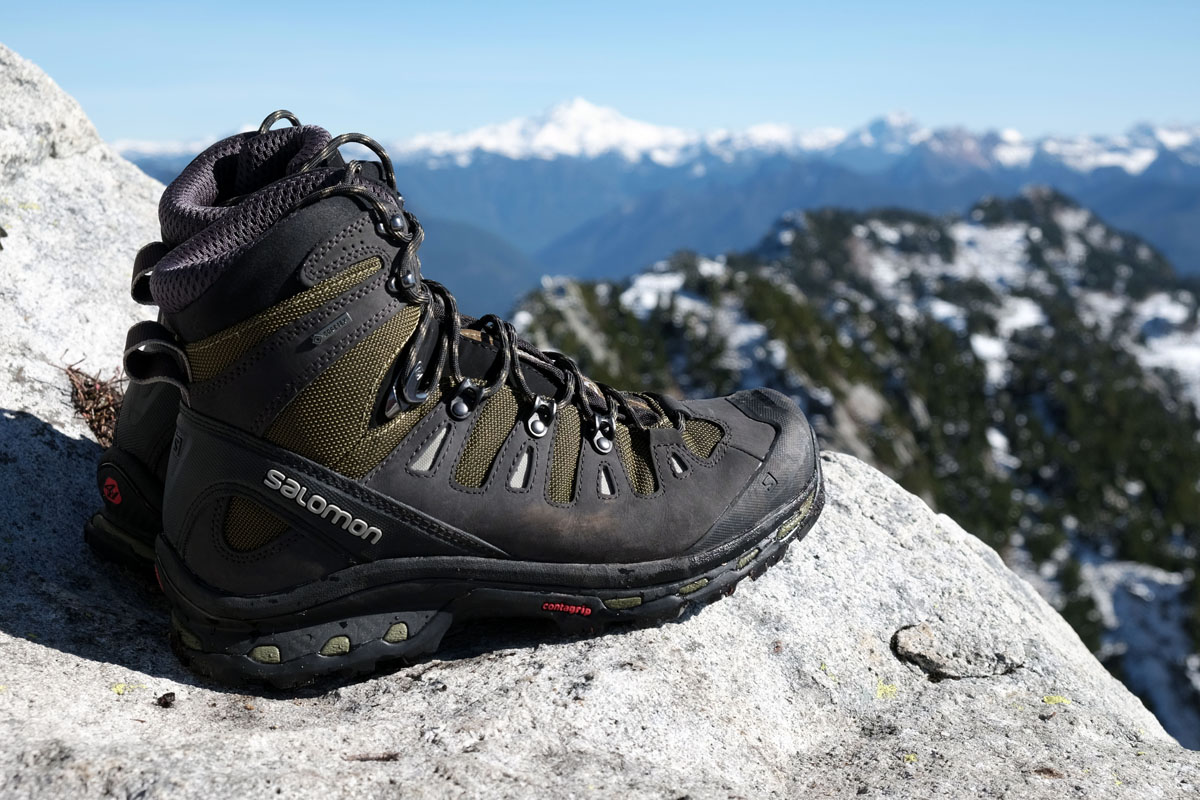
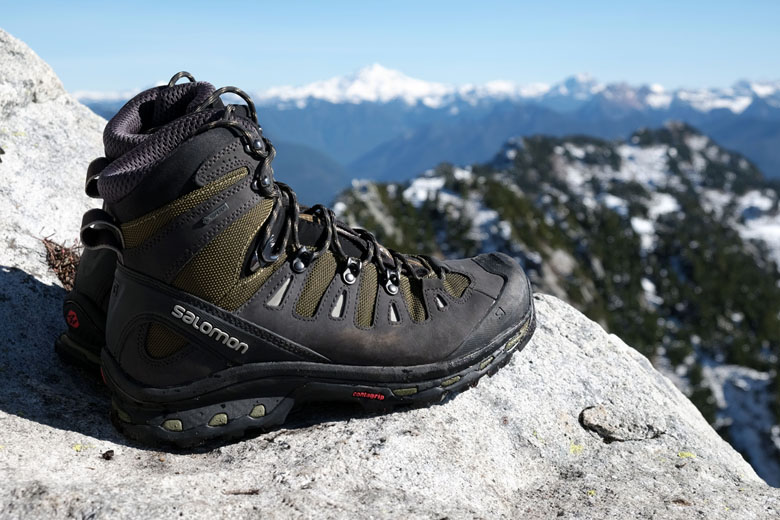
Switchback Travel


Switchback Travel
Appreciated for its light and nimble feel, the original Salomon Quest 4D GTX quickly became a go-to hiking boot for serious day-hikers and fast moving backpackers. The 2nd generation (the 4D 2 GTX) was released in spring of 2015, and Salomon has stuck to its original recipe. The updates can be summarized as the following: connecting most of the tongue to the boot’s upper for a better fit when laced up and to create a better seal, and improving the laces and rubber rand. But don’t take a lack of sweeping changes as a bad thing. Below we break down the Quest's traction, waterproofing, durability, sizing and fit, and more. To see how the Quest 4D 2 GTX stacks up, see our comparison table and article on the best hiking boots.
With an aggressive stance and a great fit around the foot and ankle, the Salomon Quest 4D 2 has truly impressive support and stability on the trail. Even with an overloaded pack full of gear to test, the performance was excellent. A big contributor is the tall boot height, which easily wraps over and around the ankle. The ankle height measures 6 inches from the insole to the top collar, quite tall for a boot in this lighter category.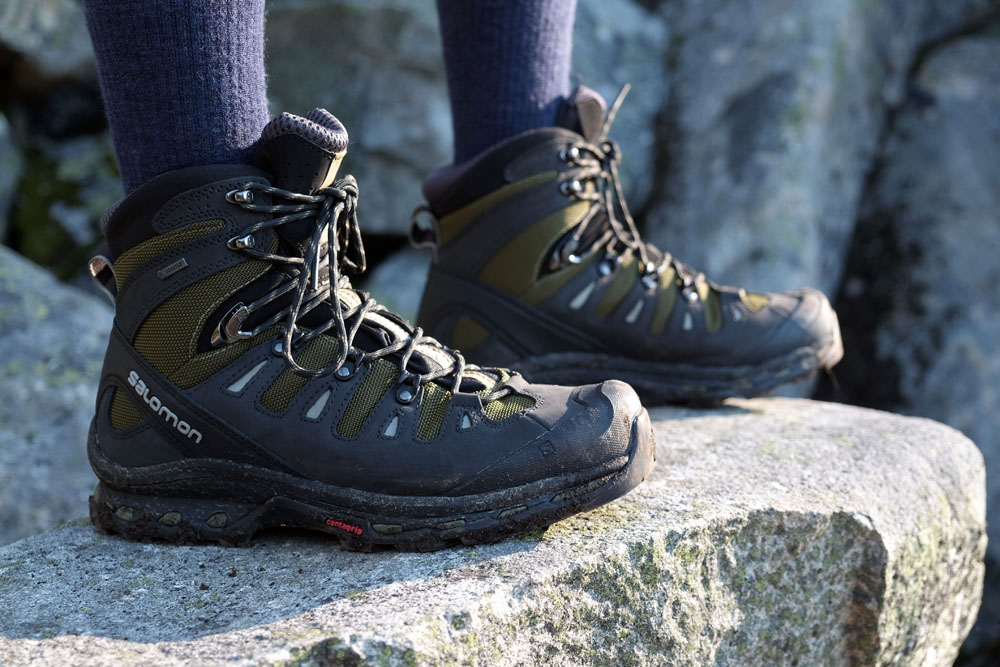
Underfoot, the 4D Chassis delivers excellent lateral stability without resorting to an excessively stiff midsole shank. But loaded down with extra water and gear for our trip in Cedar Mesa, Utah, did expose one weakness in the lightweight design—foot fatigue. Of all the backpacking boots we had along for review, the Salomon’s felt the thinnest underfoot, which over time lead to some soreness.
For perspective, this was after a 14-mile day over rocky terrain while carrying a backpacking pack exceeding 40 pounds. Lightweight backpackers and peak baggers should be just fine. On previous long mileage days when we packed a bit more conscientiously or for tougher day hikes, we did not experience the same level of underfoot discomfort.
Bucking industry trends of employing Vibram for underfoot traction, Salomon makes use of their in-house Contragrip outsoles for the Quest 4D. By no means should this be seen as a cost-cutting endeavor, as the Contragrip rubber is well known for its reliable traction in its trail running line, including the impressive Salomon Speedcross 4 (see our in-depth review).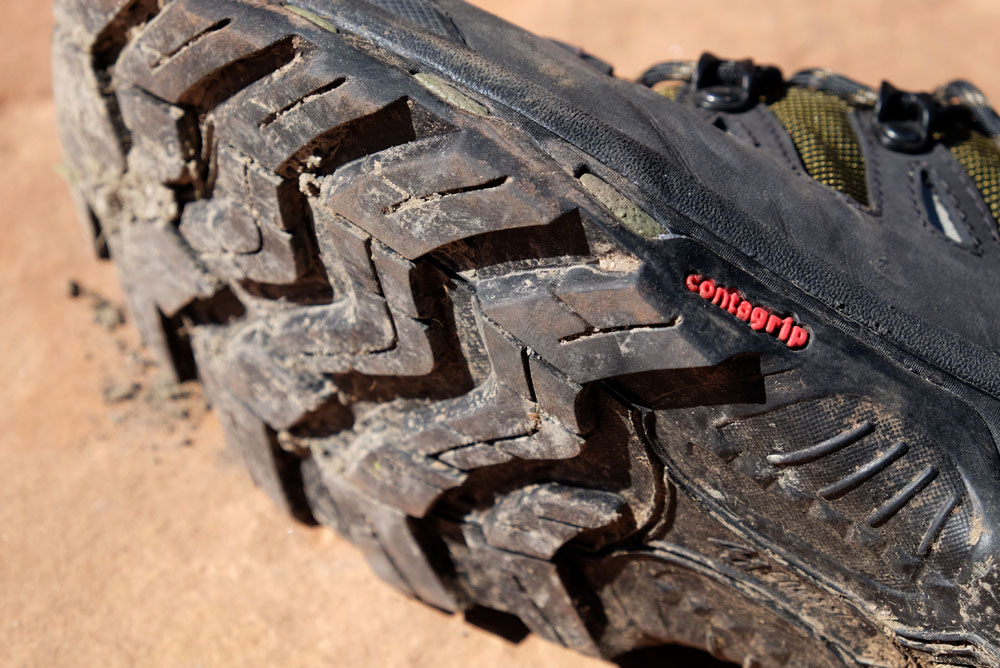
The Quest 4D’s have solid lugs that performed well over the slickrock in Utah as well as wet and muddy trails of the Pacific Northwest. Stacked up to the competition, the Contragrip rubber holds its own. The nicely spaced lugs aren’t the tallest or most aggressive looking on the market, but they are impressively grippy on the dry stuff and shed mud and clay quite well in the wet.
The tough nylon and leather construction, gusseted tongue, and Gore-Tex liner all mean that the Quest 4D 2 is a fine performer in the wet. The outer fabrics shed water well, and even after sustained rainfall our feet remained completely dry on a number of early-season hikes. Additionally, the solid construction (discussed below), as well as the long-lasting nature of the original Quest boots, leads us to believe they should remain waterproof should you take the time to clean the boots periodically.
Waterproof hiking boots will run warmer in hot weather when compared with non-waterproof options, no matter the label you find on the boot's side. And the same was experienced with the Quest’s. While their part nylon mesh design means they’ll outperformed a standard full leather boot, the in-boot experience remains a bit muggy on hot desert hikes. Thankfully, the nylon mesh design does do a decent job at wicking moisture, and the interior of the boot is quick to dry. Overall, we’d chock it up as a solid year-round performer, especially considering its waterproof design.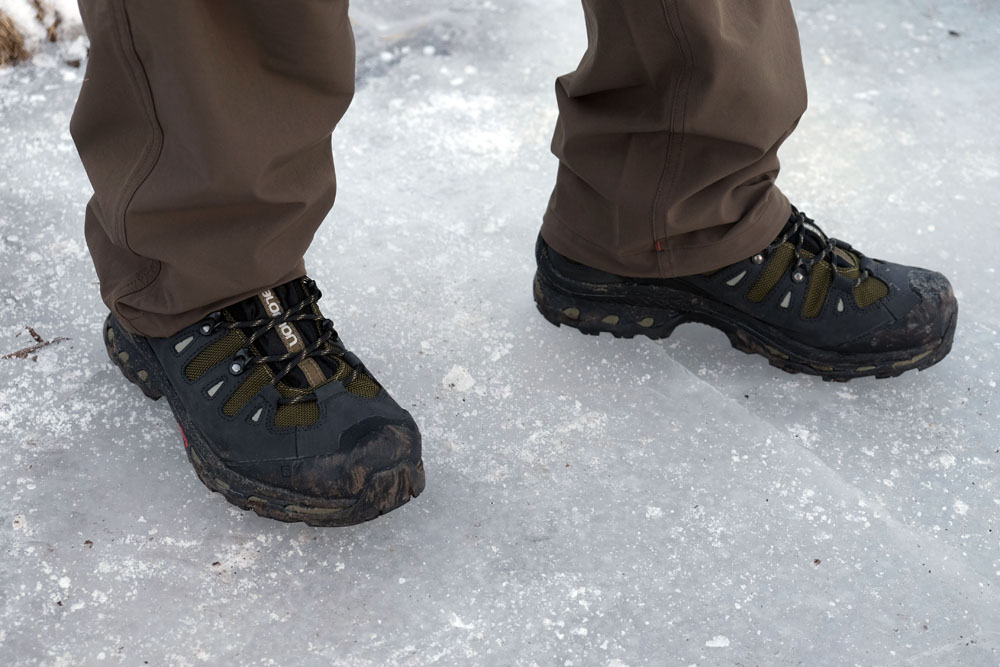
Photos in no way do the boot’s tough construction justice. What may appear on screen as tear prone mesh is in fact a burly woven nylon that is extremely abrasion resistant. A lot of our testing involved scrambling up, around and between rocks and brush and we were left very impressed with the material quality. The Nubuck leather did suffer a few scrapes near the outside of the foot, but the damage was purely cosmetic.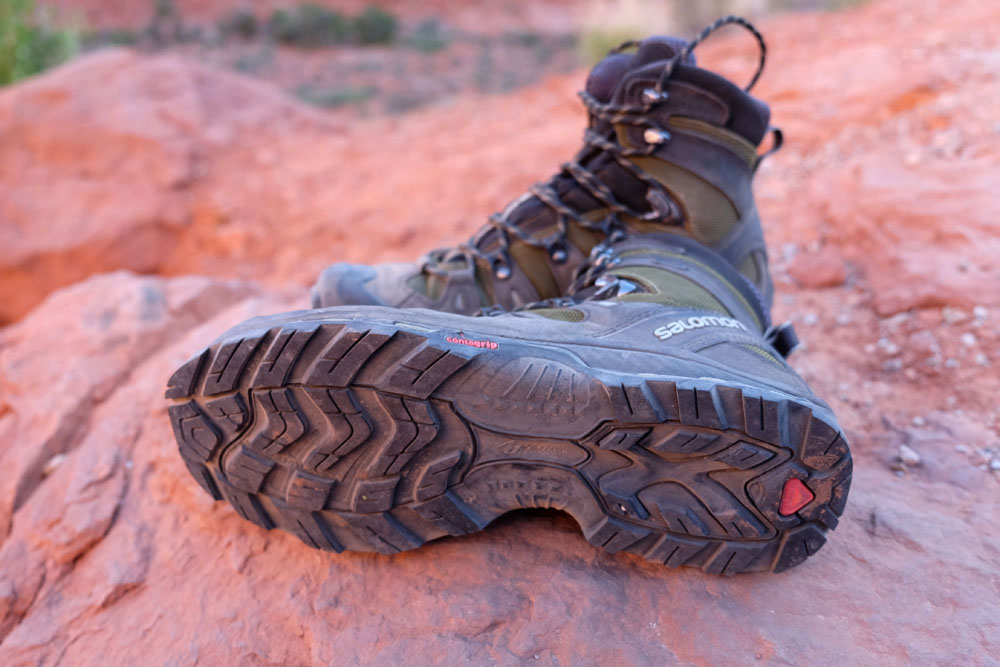
Another initial concern of ours was the amount of exposed stitching used in the construction, connecting the nylon and leather pieces together. But as with the previous generation Quest 4D boots, we’ve experienced absolutely zero issues with the threads coming loose. And that’s true of the boot as a whole. The construction is absolutely top notch from the well-built lacing system to the adhesive connecting the uppers to the rubber sole.
One of the benefits in stepping up to a full-on backpacking-ready boot is the addition of rock absorbing protection. As one of our editors experienced in the Utah canyon country, catching a toe on a rock without a substantial toe cap is a painful, nail bending experience. Thankfully, Salomon didn’t skimp on toe protection, with a rubber cap that is plenty tough and wraps around the sides, offering similar protection as some of its primary competitors: the Lowa Renegade, Vasque St. Elias, and Asolo Fugitive. The more expensive Arc'teryx Bora2 offers even more protection with its unique thermolaminated textile construction (see the in-depth review), but that's overkill for most trails. The Quest's prominent rubber rand that covers the sides of the boots is a notable upgrade from the previous generation.
Due to the high boot height, tough materials and the snug fit, ankle protection should be top notch. And after squeezing between rocks while scrambling through Cedar Mesa and Canyonlands, we can absolutely confirm this. You also get a decent amount of cushion around the ankles should you accidently tap a rock.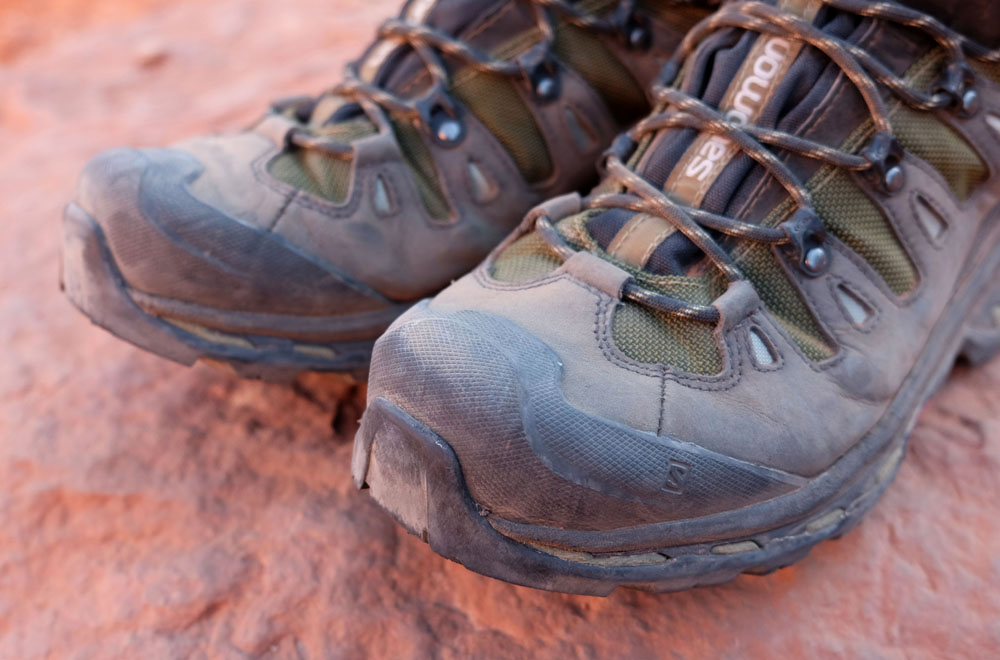
Billed as a lightweight but supportive backpacking ready boot, the Salomon’s weigh in at 2 pounds 14 ounces in a size 9. While that definitely puts them on the lighter weight end, we were actually expecting them to weigh even less. Under your feet, the boots have a ready-to-go kind of feel that gives them the impression of being even lighter. No matter the actual measured weight, we are impressed with the amount of support and protection Salomon managed to extract from a sub 3-pound backpacking boot.
The fit is low volume for hiking boots, equivalent to a performance-fitting piece of gear. In our experience, this didn’t necessitate changing sizes, as the toe box and heel offer sufficient space for longer days on the trail. The overall length is as expected, with enough room to accommodate our swollen feet following a hot weather and heavy hauling backpacking trip in Utah. Those with wide feet may have to go with another option, like the Lowa Renegade GTX.
The Quest 4D’s lacing system is a strong point of the boot, with the kind of design you lace-up once in the morning and don’t have to worry about all day. A big contributor is the set of lace hooks found at the bend in the ankle. These hooks are farther back from the rest, designed to lock in the heel. This is a point of weakness for a number of backpacking boots we have tested, and a slipping heel can spell trouble for those prone to blisters or hotspots. That open hook, as well as the top two sets of hooks around the ankle, pinches the new, tight holding laces, effectively keeping everything in place.
We were impressed with the level of comfort right out of the box. The mixed application of nylon and Nubuck leather is decently flexible, and the boot isn’t very stiff underfoot, so we had no ill effects from taking it straight to the trail for a number of day hikes. That level of comfort continued throughout our entire test period; the only hiccups were a few cases of foot fatigue on backpacking trips that we address below.
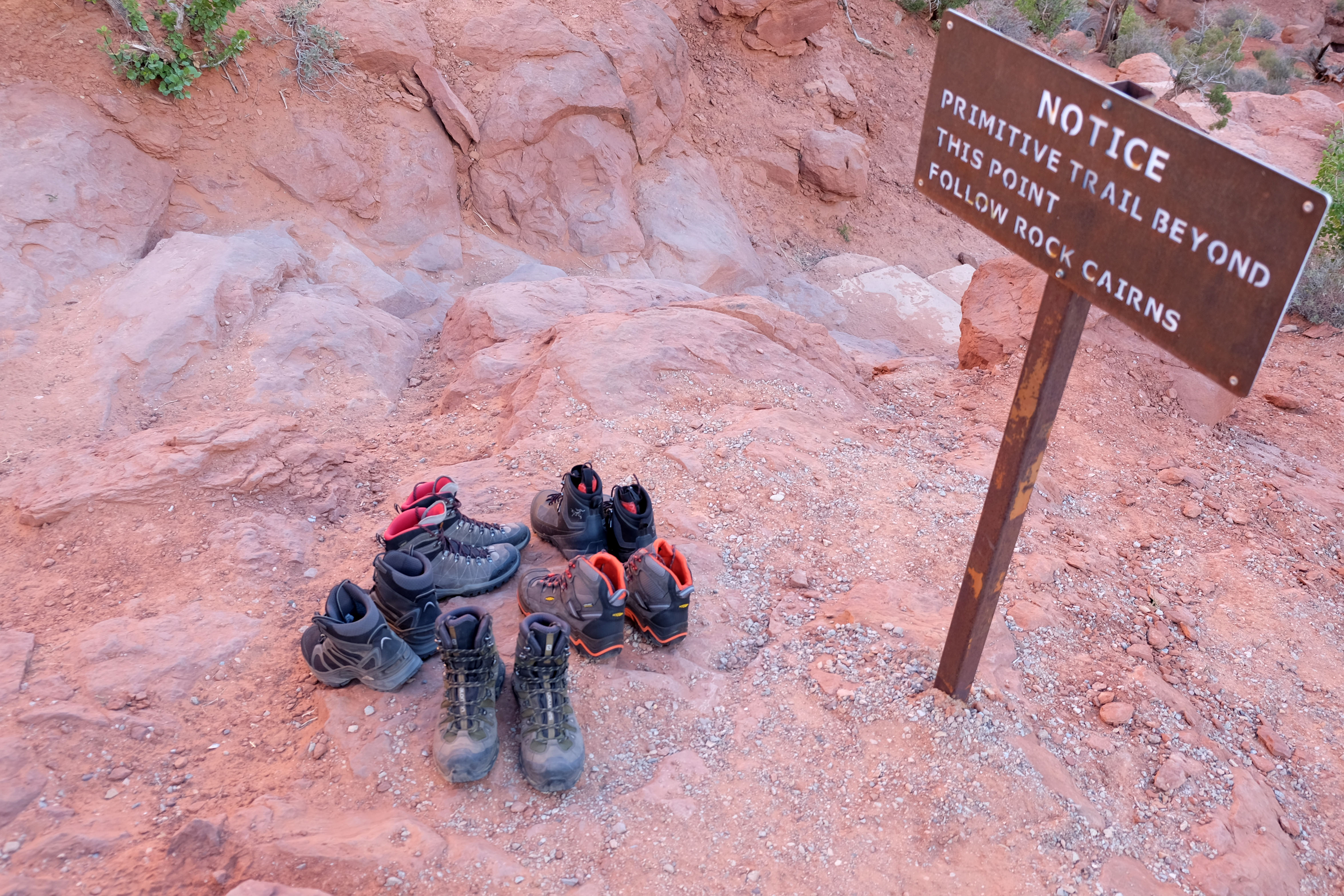
| Boot | Price | Category | Weight | Waterproof | Upper |
|---|---|---|---|---|---|
| Salomon Quest 4D 2 GTX | $230 | Midweight | 2 lb. 13 oz. | Yes (Gore-Tex) | Nubuck leather / mesh |
| Lowa Renegade GTX Mid | $230 | Midweight | 2 lb. 7 oz. | Yes (Gore-Tex) | Nubuck leather |
| Vasque St. Elias GTX | $199 | Heavyweight | 3 lb. 1 oz. | Yes (Gore-Tex) | Nubuck leather |
| Asolo Fugitive GTX | $240 | Heavyweight | 3 lb. 1 oz. | Yes (Gore-Tex) | Suede leather / nylon |
| Scarpa R-Evolution GTX | $239 | Midweight | 2 lb. 14 oz. | Yes (Gore-Tex) | Suede leather |
The Salomon Quest 4D 2 falls into the midweight boot category in terms of ankle height, stiffness, total weight, and build quality. This separates it from a less supportive (and cheaper) day hiking boot like the Merrell Moab Waterproof; instead, the Quest goes head-to-head with backpacking models like the Lowa Renegade GTX, Vasque St. Elias GTX, and Asolo Fugitive GTX. From that grouping, the Salomon feels the most aggressive—the Fugitive and St. Elias are heavier (and feel it), while the Lowa is a closer match.
Both the Salomon Quest and Lowa Renegade retail for $230 and mix weight with excellent traction and comfort for technical trails and multiday backpacking trips. Between the two, we think those with wide feet or who want a more traditional boot feel will prefer the leather Renegade GTX (for more information, see our in-depth review). But we gave the overall edge to the Quest in our hiking boot round-up for its modern stance, performance fit, and trail runner-like feel.